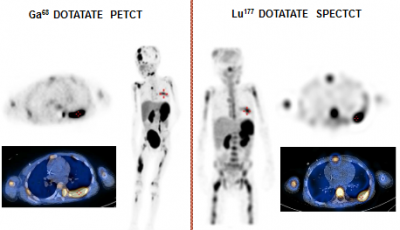Molecular radiotherapy (MRT) may be defined as the delivery of radiation to malignant tissue via the interaction of a radiopharmaceutical with molecular sites and receptors. This is a rapidly evolving discipline, particularly with regard to quantification of uptake in normal and malignant tissue. Internal dosimetry is essential to the future development of MRT.
Of interest are the radiopharmaceuticals 131I-mIBG and 177Lu-DOTATATE.
Metaiodobenzylguanidine (mIBG) is highly sensitive and specific for neuroblastoma (a form of childhood cancer), concentrating in >90% of tumours. It may be labelled to 123I as a routine tool for neuroblastoma gamma camera and SPECT-CT imaging. Patients eligible for treatment may be treated with 131I-mIBG, often in combination with a radiosensitiser such as Topotecan. Therapies are performed on an in-patient basis in one of the radionuclide therapy rooms within UCLH. Response rates are monitored using imaging techniques within INM.
Further work with mIBG involves using 124I-mIBG as a novel PET radiotracer, with the ability to offer improved spatial resolution and quantification. We aim to compare 124I-mIBG PET/CT to 123I-mIBG scintigraphy in their ability to detect lesions in metastatic neuroblastoma.
Another well-established technique is 68Ga-DOTATATE PETCT imaging. This is a useful diagnostic tool to determine disease extent and evaluate patients for targeted 177Lu-DOTATATE therapy. A phase 2 trial is currently underway to evaluate 177Lu-DOTATATE therapy in the treatment of refractory or relapsed neuroblastoma. Key components of the trial are evaluating 68Ga-DOTATATE uptake correlation with response and a dosimetry study to investigate tumour and normal organ dose.

 Close
Close

